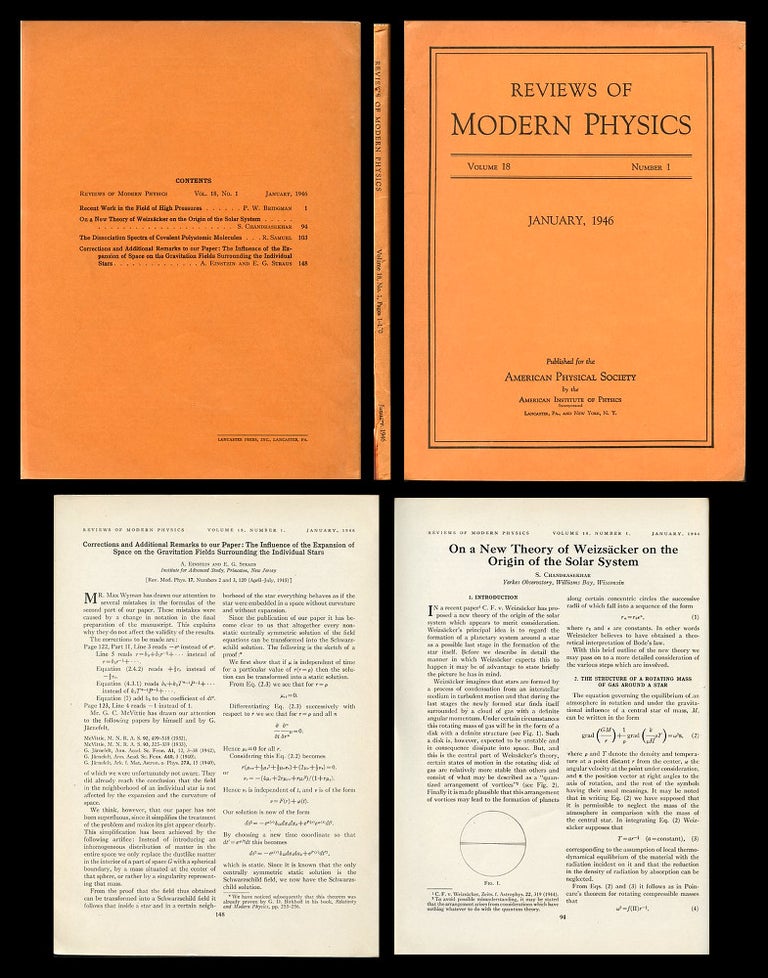Corrections and Additional Remarks to Our Paper (Einstein & Strauss) WITH On a New Theory of Weizsäcker on the Origin of the Solar System in Reviews of Modern Physics, 18, January 1946, pp. 148-149; pp. 94-103
Lancaster: American Physical Society, 1946. 1st Edition. FIRST EDITION IN ORIGINAL WRAPS OF SIGNIFICANT CORRECTIONS & ADDITIONS BY EINSTEIN & STRAUS TO AN IMPORTANT PAPER; AS WELL, A PAPER BY CHANDRASEKHAR ON THE ORIGIN OF THE SOLAR SYSTEM.
In 1945 Albert Einstein and Ernst G. Straus introduced their Swiss cheese model of the universe in a paper entitled “The Influence of the Expansion of Space on the Gravitation Fields Surrounding the Individual Stars”. (Weil 216). The following year they published “Corrections and Additional Remarks to Our Paper” (the 1945 paper), the paper offered here.
In early 1945, Einstein returned to long held cosmological questions as he sought to try to understand whether the expansion of the universe caused the solar system to expand as well — or more specifically, the influence of the expansion of space on the gravitational field in the neighborhood of a star. Working with Straus, the two began studying the effect of inhomogeneities in an expanding model.
“By the spring of 1945, Einstein and Straus had found a new type of possible universe using Einstein’s equations. It described a universe which looked largely like one of the simple expanding universes of Friedmann and Lemaître containing material (like galaxies) which exerted no pressure. But it has spherical regions removed from it, like bubbles in a Swiss cheese. Each empty hole then had a mass placed at its centre. The mass was equal in magnitude to what had been excavated to create the hole. This was a step towards a more realistic universe in which the matter was not smoothly spread with the same density everywhere but gathered up into lumps, like galaxies, which were spread about in empty space. (Barrow, The Book of Universes, 106-107).
ALSO INCLUDED: S. Chandrasekhar’s “On a New Theory of Weizsäcker on the Origin of the Solar System”. In 1945, C. F. v. Weizsäcker proposed a new theory of the origin of the solar system which appeared to merit consideration. Weizsäcker argued “that there [would be] turbulence in the solar nebula which would give rise to the formation of eddies having angular motion opposite to that of the rotation of the nebula” (Abhyankar, The Origin, BASI, 26, 339). Weizsäcker’s “principal idea [was] to regard the formation of a planetary system around a star as a possible last stage in the formation of the star itself” (Chandrasekhar, 1946, 94). He believed that “the protoplanets were supposed to have formed at the sites of the ball bearing eddies and the merger of the protoplanets in the same orbit produced the known planets” (Abhyankar, 343). In the paper offered here, the Indian American astrophysicist S. Chandrasekhar challenged Weizsäcker’s theory and showed “that there will be a wide spectrum of turbulence with smaller eddies within the larger ones and there would be no regular pattern as suggested by Weizsäcker. Further the life time of the eddies will be too short for the formation of the planets” (ibid). In other words, Chandrasekhar’s work “indicated that the regular pattern of vortices originally postulated by Weizsäcker could not occur, but instead must be replaced by a range of eddy sizes” (Brush, A History of Modern Planetary Physics, 14). Chandrasekhar’s work led to the abandonment of Weizsäcker’s theories.
INCLUDED: Nobel Prize winner Percy Williams Bridgman’s “Recent Work in the Field of High Pressures,” pp. 1-94 (an important review of work done in the field of high pressure physics between Bridgman’s seminal 1930 work and 1946, the year he won the prize) and R. Samuel’s “The Dissociation Spectra of Covalent Polyatomic Molecules”, pp. 103-148. Item #858
CONDITION & DETAILS: Lancaster: American Physical Society. Complete issue in original wraps. 4to. (10.5 x 8 inches; 263 x 200mm). Very slight wear at the edges of the wraps and head and foot of the spine; small closed tear (see images). Bright and clean throughout. Very good condition.
Price: $180.00

